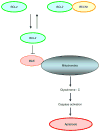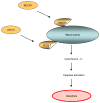The role of cell signalling in the crosstalk between autophagy and apoptosis
- PMID: 24308968
- PMCID: PMC4054685
- DOI: 10.1016/j.cellsig.2013.11.028
The role of cell signalling in the crosstalk between autophagy and apoptosis
Abstract
Not surprisingly, the death of a cell is a complex and well controlled process. For several decades, apoptosis, the first genetically programmed death process to be identified has taken centre stage as the principal mechanism of programmed cell death (type I cell death) in mammalian tissues. Apoptosis has been extensively studied and its contribution to the pathogenesis of disease well documented. However, apoptosis does not function alone in determining the fate of a cell. More recently, autophagy, a process in which de novo formed membrane enclosed vesicles engulf and consume cellular components, has been shown to engage in complex interplay with apoptosis. As a result, cell death has been subdivided into the categories apoptosis (Type I), autophagic cell death (Type II), and necrosis (Type III). The boundary between Type I and II cell death is not completely clear and as we will discuss in this review and perhaps a discrete difference does not exist, due to intrinsic factors among different cell types and crosstalk among organelles within each cell type. Apoptosis may begin with autophagy and autophagy can often end with apoptosis, inhibition or a blockade of caspase activity may lead a cell to default into Type II cell death from Type I.
Keywords: Apoptosis; Autophagosome; Autophagy; Caspase; Sorafenib.
Published by Elsevier Inc.
Figures





Similar articles
-
Astemizole-Histamine induces Beclin-1-independent autophagy by targeting p53-dependent crosstalk between autophagy and apoptosis.Cancer Lett. 2016 Mar 1;372(1):89-100. doi: 10.1016/j.canlet.2015.12.024. Epub 2015 Dec 29. Cancer Lett. 2016. PMID: 26739061
-
Impaired autophagy and APP processing in Alzheimer's disease: The potential role of Beclin 1 interactome.Prog Neurobiol. 2013 Jul-Aug;106-107:33-54. doi: 10.1016/j.pneurobio.2013.06.002. Epub 2013 Jul 1. Prog Neurobiol. 2013. PMID: 23827971 Review.
-
Autophagy promotes T-cell survival through degradation of proteins of the cell death machinery.Cell Death Differ. 2012 Jan;19(1):144-52. doi: 10.1038/cdd.2011.78. Epub 2011 Jun 10. Cell Death Differ. 2012. PMID: 21660048 Free PMC article.
-
Life and death partners: apoptosis, autophagy and the cross-talk between them.Cell Death Differ. 2009 Jul;16(7):966-75. doi: 10.1038/cdd.2009.33. Epub 2009 Mar 27. Cell Death Differ. 2009. PMID: 19325568 Review.
-
Self-consumption: the interplay of autophagy and apoptosis.Nat Rev Mol Cell Biol. 2014 Feb;15(2):81-94. doi: 10.1038/nrm3735. Epub 2014 Jan 8. Nat Rev Mol Cell Biol. 2014. PMID: 24401948 Free PMC article. Review.
Cited by
-
Expression of cell cycle and apoptosis regulators in thymus and thymic epithelial tumors.Clin Exp Med. 2016 May;16(2):147-59. doi: 10.1007/s10238-015-0344-7. Epub 2015 Mar 21. Clin Exp Med. 2016. PMID: 25794494 Review.
-
Blockade on Lin28a Prevents Cognitive Impairment and Disruption of the Blood-Brain Barrier Induced by Chronic Cerebral Hypoperfusion.Biomedicines. 2022 Apr 5;10(4):852. doi: 10.3390/biomedicines10040852. Biomedicines. 2022. PMID: 35453602 Free PMC article.
-
HIF-1α Activation Promotes Luteolysis by Enhancing ROS Levels in the Corpus Luteum of Pseudopregnant Rats.Oxid Med Cell Longev. 2021 Sep 1;2021:1764929. doi: 10.1155/2021/1764929. eCollection 2021. Oxid Med Cell Longev. 2021. PMID: 34512862 Free PMC article.
-
DRAM Is Involved in Regulating Nucleoside Analog-Induced Neuronal Autophagy in a p53-Independent Manner.Mol Neurobiol. 2018 Mar;55(3):1988-1997. doi: 10.1007/s12035-017-0426-5. Epub 2017 Mar 6. Mol Neurobiol. 2018. PMID: 28265856
-
Thioredoxin-2 protects against oxygen-glucose deprivation/reperfusion injury by inhibiting autophagy and apoptosis in H9c2 cardiomyocytes.Am J Transl Res. 2017 Mar 15;9(3):1471-1482. eCollection 2017. Am J Transl Res. 2017. PMID: 28386372 Free PMC article.
References
Publication types
MeSH terms
Substances
Grants and funding
LinkOut - more resources
Full Text Sources
Other Literature Sources
Research Materials

